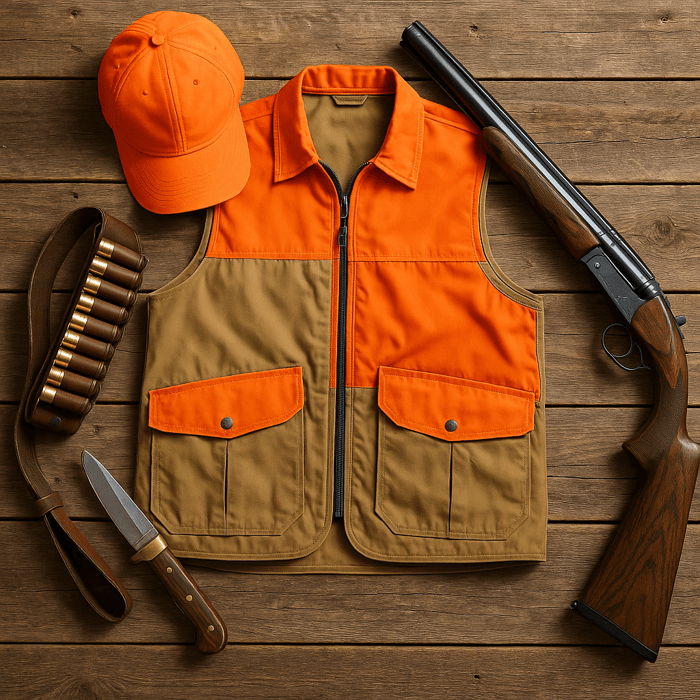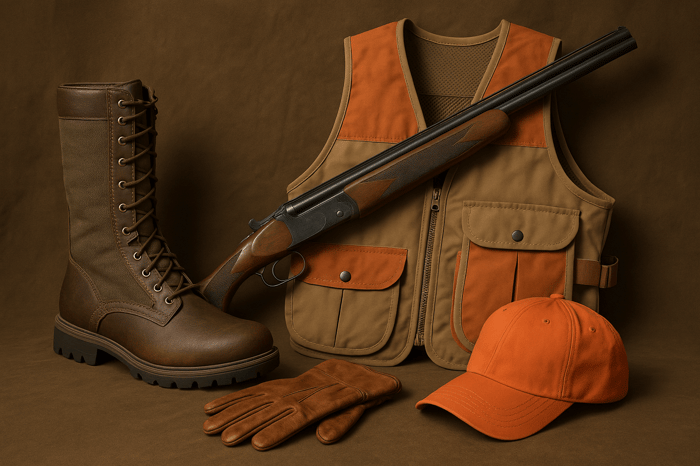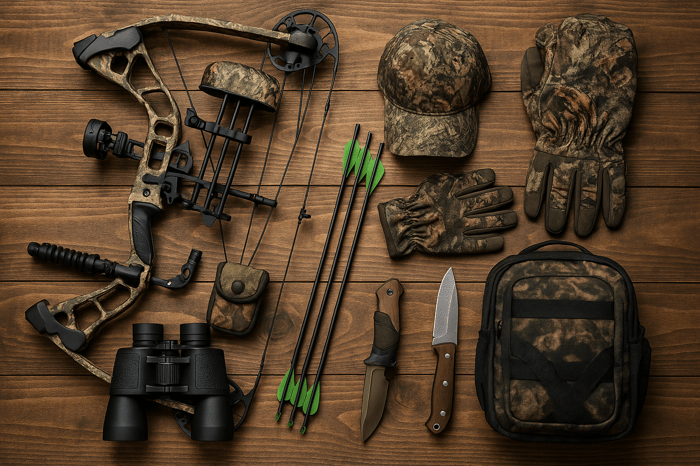Upland hunting is an exhilarating way to immerse yourself in the outdoors, chasing game birds like pheasants, quail, or grouse across fields, forests, and rolling hills. For beginners, the excitement of planning your first hunt can quickly turn to overwhelm when faced with the vast array of gear options. That's where this Beginner's Guide to Upland Hunting Gear: What You Really Need is here to help. This complete guide will take you through the must-haves, show you how to prioritize what you need, steer you around common mistakes, and create a kit that's not only functional but also affordable. With the proper gear, you'll be comfortable facing your first upland experience.
This Beginner's Guide to Upland Hunting Gear: What You Really Need is written to make your prep work easy, using gear that will get you the balance of function, durability, and comfort you need. Solo or with a furry friend by your side, we'll take you through it all from head to toe, from clothes to guns, accessories, and safety elements. Let's get down to business so you're properly prepared for the field.
Why Proper Gear Matters for Upland Hunting
Upland hunting has distinctive requirements. You'll find yourself hiking for hours over challenging country, pushing through heavy cover, and braving capricious weather. Proper equipment keeps you safe, comfortable, and on the hunt, not fighting with substandard gear. A judiciously prepared kit, as detailed in this Beginner's Guide to Upland Hunting Gear: What You Really Need, gets you ready for the physical demands so you can maximize the experience.
Without the right gear, you can expect problems such as blisters caused by substandard boots, discomfort caused by poor apparel, or even safety problems from low-visibility clothing. This book prioritizes quality over quantity, guiding you to invest in gear that will last and stay out of your pack.
Clothing: Establishing a Foundation for Comfort
Layering for All Conditions
One of the earliest concepts in any Beginner's Guide to Upland Huntings Gear: What You Really Need is learning to layer. Upland seasons tend to extend into fall and early winter, so you'll have a combination of cold mornings, warm afternoons, and pop-up rain showers. A layer system lets you adjust to these variations.
Base Layer: Start with a moisture-wicking base layer made of materials like merino wool or synthetic fabrics. These keep sweat off your skin, preventing chills during long hikes.
Mid-Layer: Add an insulating layer, such as a fleece pullover or lightweight down jacket, for warmth. Look for breathable options to avoid overheating.
Outer Layer: A waterproof and wind-resistant jacket is vital for rain, wind, or thorny brush protection. Many hunters wear jackets with blaze orange panels for safety.
Here's a suggestion from this Beginner's Guide to Upland Huntings Gear: What You Really Need to test your layers prior to your hunt to make sure they are comfortable and provide full range of motion.
Durable Pants for Tough Terrain
Your legs will be tested day and night in the field, from thorns to soggy spots. Upland hunting pants must be constructed from robust materials such as canvas, nylon, or cotton blend that is tear-resistant. Brush-resistant fabrics and reinforced knees are a favorite among many hunters. Blaze orange or high-vis patches are an added bonus for safety, particularly in group hunts.
Fit is important too—pants need to be fitted enough not to snag but loose enough to move around in. A few brands have adjustable waists or zip-off legs for flexibility. This Beginner's Guide to Upland Huntings Gear: What You Really Need recommends spending money on a pair that balances wearability with airiness.
Boots: Your Foundation in the Field
Footwear is one of the most critical components of your kit. Upland hunting involves long walks over uneven ground, so your boots need to be tough, supportive, and comfortable. Look for waterproof boots with ankle support and aggressive treads for traction. Leather boots with Gore-Tex linings are popular for their durability and weather resistance.
Break in your boots well in advance of your hunt so you don't get blisters. Proper moisture-wicking socks, wool or synthetic, will keep your feet dry and cushioned. This Beginner's Guide to Upland Huntings Gear: What You Really Need can't emphasize strongly enough the difference proper footwear makes in your experience.
Hats, Gloves, and Safety Vests
Small accessories make a big difference. A wide-brimmed hat shields your eyes from the sun and protects your face from branches. Lightweight, durable gloves protect your hands from thorns, cold, or the recoil of your shotgun. A blaze orange safety vest is non-negotiable in most hunting areas—it ensures you’re visible to other hunters, reducing the risk of accidents.
Other vests, however, combine protection with practicality, having shell or snack pockets. This Beginner's Guide to Upland Huntings Gear: What You Really Need recommends a vest with breathable mesh for hot weather days and adjustable straps for comfort.
Firearms: Selecting the Right Shotgun
Selecting the Ideal Shotgun
The shotgun is the foundation of upland hunting. A 12-gauge or 20-gauge shotgun is best for a novice because of its use across a variety of game birds. Over-under or side-by-side shotguns are favorite among shooters because of their reliability, balance, and ease of handling. Pump-action shotguns are another cost-effective option, although they are a bit heavier.
When selecting a shotgun, weight and fit are important. Upland hunting means you're carrying your weapon for hours, so a light model (about 6–7 pounds) is the best. Go to a gun store to try the fit—your shotgun must feel like an extension of your body. This Beginner's Guide to Upland Hunting Gear: What You Really Need suggests brands such as Beretta, Browning, or Benelli for quality entry-level models.
Ammunition for Different Game
Your ammo should match the birds you’re targeting. For smaller game like quail or doves, use lighter loads such as #7.5 or #8 shot. For larger birds like pheasants or grouse, opt for #5 or #6 shot for better stopping power. Lead shot is common, but some areas require non-toxic alternatives like steel or bismuth due to environmental regulations.
Carry at least 25–50 shells in a vest or belt, since you can take multiple shots on a flush. Shoot with your selected ammo to see how it patterns and its range. This Beginner's Guide to Upland Hunting Gear: What You Really Need stresses the necessity of range time for confidence and accuracy building.
Essential Accessories for Upland Hunting
Hunting Vest or Backpack
A quality hunting vest or backpack is a must for carrying your essentials. Look for a vest with multiple pockets for shells, a water bottle, snacks, and a first-aid kit. A game pouch in the back is perfect for storing harvested birds. Blaze orange vests with breathable mesh panels are ideal for warm weather, while insulated options work for colder days.
If you find a backpack more comfortable, use a light one with shoulder padding and hydration system. This Beginner's Guide to Upland Hunting Gear: What You Really Need recommends testing out vests or packs to make sure that they don't hinder your movement.
Navigation and Communication Tools
Upland hunting frequently leads you into the boonies, so navigation equipment is essential. A handheld GPS or a smartphone application such as onX Hunt can assist you in following your position and noting important locations such as your truck or a water source. A compass and paper map serve as good fall-backs should your battery die.
For group hunts, two-way radios enable you to remain in communication with your party. A simple first-aid kit of bandages, antiseptic, and painkillers is also necessary for minor wounds. These items are easy to forget but crucial, as pointed out in this Beginner's Guide to Upland Hunting Gear: What You Really Need.
Hydration and Nutrition
Long field days require adequate hydration and energy. Use a light hydration bladder or water bottle, holding 1–2 liters. Include high-energy snacks such as trail mix, protein bars, or jerky to maintain energy levels. Some hunters take a thermos of coffee or soup for cold mornings.
This Beginner's Guide to Upland Hunting Gear: What You Really Need advises preparing for a minimum of one liter of water per individual for a half-day hunt, increasing it if you're taking a dog along.
Dog Gear: Outfitting Your Hunting Companion
If you're hunting with a dog, their equipment is just as significant as yours. Having a properly outfitted dog can ease the flushing and retrieval of birds significantly. This Beginner's Guide to Upland Hunting Gear: What You Really Need is an overview of the essentials for your dog.
Collars and Tracking Devices
A heavy bell or beeper on a long-lasting collar assists you in finding your dog when in thick cover. GPS electronic collars are more expensive but provide real-time position reports, which are a godsend in thick or unknown country. A heavy-duty leash is required for training or holding your dog close in prohibited areas.
Protective Gear for Dogs
Rough ground can be harsh on your dog's paws, so think about skid boots to shield them from rocks or thorns. A blaze orange vest makes sure your dog stands out to other hunters. Cooling vests keep your dog cool on hot days. This Beginner's Guide to Upland Hunting Gear: What You Really Need emphasizes having your dog safe and comfortable.
Food and Water for Your Dog
Pack food bowls and water bowls that are portable, and bring enough for the day. A healthy, well-fed, well-hydrated dog works better and remains healthy. Collapsible bowls for storage are used by some hunters. This Beginner's Guide to Upland Hunting Gear: What You Really Need recommends checking a dog's condition during the hunt in order to see if they're getting too tired.
Safety First: Protecting Yourself and Others
Safety is the key to any successful hunt. Always wear blaze orange clothing, a vest and hat, to be visible. Handle every firearm as if it were loaded, and keep the muzzle pointed in a safe direction. This Beginner's Guide to Upland Hunting Gear: What You Really Need highly recommends that you take a hunter safety course, which teaches you about firearm handling, field etiquette, and wildlife regulations.
Carry a signal or whistle device in the event you become lost from your group. In cold weather hunting, bring hand warmers or additional layers to avoid hypothermia. Preparing for emergencies is an important take-away from this Beginner's Guide to Upland Hunting Gear: What You Really Need.
Budgeting for Your Upland Hunting Gear
You don't have to break the bank to get started, but good gear is worth the money. This Beginner's Guide to Upland Hunting Gear: What You Really Need recommends beginning with mid-range gear and gradually moving up as you develop experience. Here's a breakdown of costs:
Shotgun: $500–$1,500 for a good beginner shotgun.
Clothing (pants, boots, vest, layers): $200–$500, depending on brands and materials.
Ammunition and Accessories: $100–$300 for shells, a cleaning kit, and navigation equipment.
Dog Gear (if necessary): $100–$400 for collars, vests, and boots.
Shop sales, secondhand shops, or online venues such as eBay for bargains. Don't skimp on safety equipment such as blaze orange vests or first-aid kits. This Beginner's Guide to Upland Hunting Gear: What You Really Need urges assembling your kit piecemeal in order to distribute costs.
Keeping Your Gear Going for Years
Proper care extends the life of your equipment. Clean your shotgun after each hunt to remove dirt and prevent rust. Use a gun oil to lubricate moving parts. Wash clothing and vests to remove dirt, sweat, and game odors, following the manufacturer’s instructions. Store boots in a dry, cool place to prevent mold or cracking.
For dog equipment, check collars, vests, and boots for deterioration and replace the damaged ones. This Beginner's Guide to Upland Hunting Gear: What You Really Need focuses on regular maintenance to ensure that your gear is in good condition.
Common Beginner Mistakes to Avoid
New hunters tend to make unnecessary mistakes. Overpacking is a common one—adhere to the essentials described in this Beginner's Guide to Upland Hunting Gear: What You Really Need. Another blunder is forgetting about comfort; always pre-test your boots, clothing, and vest prior to an extended hunt. Not practicing with your shotgun will also result in missed shots or unsafe gun handling.
Don't disregard local laws. Research hunting seasons, licenses, and land access regulations to prevent fines. This Beginner's Guide to Upland Hunting Gear: What You Really Need recommends that you join a local hunting club or mentorship program to get tips from experienced hunters.
Where to Buy Quality Upland Hunting Gear
You'll be able to find solid equipment at outdoor stores such as Cabela's, Bass Pro Shops, or REI. Online retailers such as Amazon, MidwayUSA, or Sportsman's Warehouse provide a great choice and reviews from customers. Local gun shops are excellent sources of firearms and ammunition specifically suited for your area's game. This Beginner's Guide to Upland Hunting Gear: What You Really Need recommends price comparison and review of return policies prior to purchase.
For dog equipment, specialty stores such as Gun Dog Supply or Lion Country Supply provide top-notch choices. Secondhand shops or hunting bulletin boards can be a treasure trove for lightly used equipment at half the price.
Preparing for Your First Upland Hunt
Before you head out on your first hunt, double check your equipment against this Beginner's Guide to Upland Hunting Equipment: What You Really Need. Travel light but wisely, carrying only the essentials such as water, ammunition, and safety equipment. Scout your hunting location beforehand, recording terrain, water, and parking locations. Review local regulations regarding licenses, bag limits, and blaze orange.
If you're hunting with a dog, make sure they're field-broke and used to your equipment. Master simple commands such as "stay" and "come" so your dog doesn't create chaos while flushing. Perhaps most importantly, be patient with the learning process—upland hunting is one of those skills that gets better with experience. This Beginner's Guide to Upland Hunting Gear: What You Really Need is your guide to success.
FAQs About Upland Hunting Gear
1. What's the single most important piece in a Beginner's Guide to Upland Hunting Gear: What You Really Need?
A good shotgun and blaze orange safety equipment are must-haves for safety and success on the ground.
2. Do I need a dog to hunt upland?
No, but a well-trained dog will greatly enhance your effectiveness at flushing and retrieving birds.
3. How much should I spend on upland hunting equipment?
Anticipate spending $1,000–$2,500 for a full beginner package, with a shotgun, clothing, and accessories.
4. What is the optimum shotgun gauge for beginners?
A 12-gauge or 20-gauge shotgun is useful and easy to handle for most upland game.
5. Can I use standard hiking boots for upland hunting?
Hiking boots are acceptable if they're waterproof and tough, but hunting boots provide more protection.
6. Why is blaze orange so vital?
Blaze orange makes you visible to other hunters, and thereby, minimizes accidents in the field.
7. How do I select the proper ammo for upland hunting?
Match ammo to your game—#7.5 or #8 for small birds, #5 or #6 for larger birds.
8. What do I carry in my hunting vest?
Pack shells, water, snacks, a first-aid kit, and a game pouch for birds shot.
9. How do I keep my dog's hunting equipment in good condition?
Regularly clean and check collars, vests, and boots, and replace worn or damaged ones.
10. How can I learn more about upland hunting?
This Beginner's Guide to Upland Hunting Gear: What You Really Need is a good starting point, but local hunting clubs, online forums, or mentorship programs provide worthwhile information.
Conclusion
Upland hunting is an exciting means of enjoying the outdoors, challenging yourself, and bonding with nature. Armed with the proper equipment, you'll be ready to meet the challenges of the field while remaining safe and secure. This Beginner's Guide to Upland Hunting Gear: What You Really Need has touched on all aspects of clothing and firearms, dog equipment and more, through to safety precautions. Begin with the basics, spend money on quality equipment, and be patient with practicing and learning. Your first upland hunt is just the start of a great adventure—good luck hunting!




